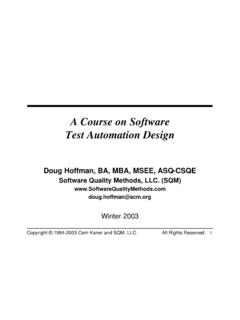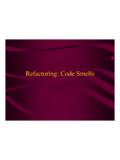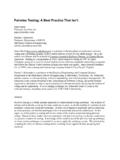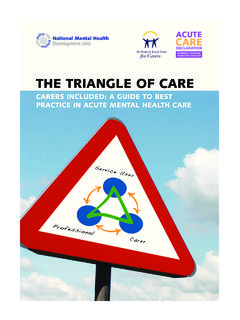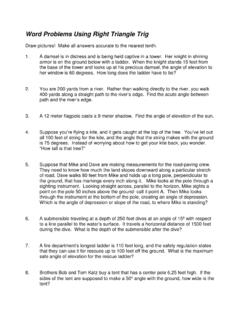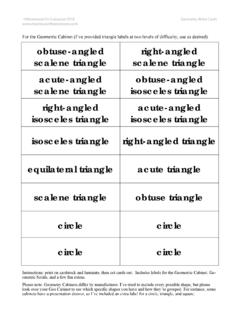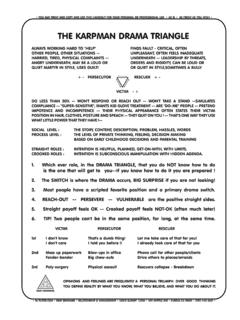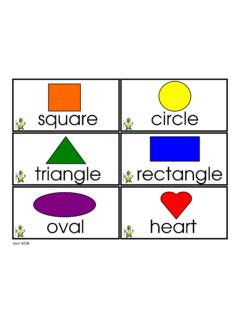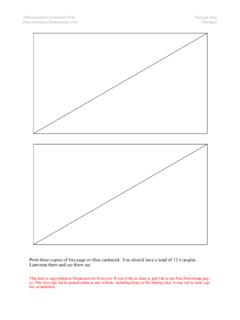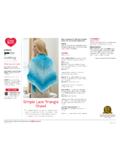Transcription of Exercise: Analyzing the Triangle Problem - Testing …
1 exercise : Analyzing the Triangle Problem Copyright Ross Collard, Collard & Company, 2004. Excerpt from my book: Developing Effective Test Cases . (Allow 15 to 20 minutes for this exercise .). Consider the following software program. It reads three input data values. These values represent the three lengths of the sides of a Triangle . The purpose of this program is to display a message which states whether the Triangle is scalene ( , no two sides are equal), isosceles (two sides equal) or equilateral (all sides equal). As software goes, this is very low in complexity. How do we test it?
2 This challenge was posited by Jerry Weinberg, and described by Glen Myers in his classic book, "The Art of Software Testing ". Develop a list of test cases for this Triangle Problem . The table format below is convenient for listing your test cases, though you do not have to follow it. I have provided the first few test cases to help you get started: Test Case Condition Being Input Data Expected Result # Tested** Values*. i j k 1. Three valid equal sides 7 7 7 Equilateral Triangle 2. Two equal valid sides 5 5 3 Isosceles Triangle 3. Two equal valid sides; 8 8 % Error message: invalid third side invalid input data value *.
3 Where i, j, and k are the names of the three sides of the Triangle . **. You may find the word condition to be vague. I mean the test requirement; the circumstance or situation which we want the test case to check. 1. Lessons and Conclusions from the Triangle Problem In experiments at IBM and other organizations, researchers asked experienced systems professionals to identify an adequate set of test cases for the Triangle Problem . The researchers gave the participants in these experiments unlimited time for this task. The results of these experiments have been judged to be deplorable: on average, people listed only about one third of the test cases needed for an adequate test.
4 In his book, Software Testing : A Craftsman's Approach , Paul Jorgensen lists about 185 test cases for this Problem . How many did you identify? I have problems with this "deplorable" interpretation. Adequacy must be assessed with regard to context. For the functionality specified in the exercise , I could argue that these four test cases are sufficient to test adequately: Test Case Input Values Expected Results 1. 3, 3, 3 Equilateral Triangle 2. 3, 3, 2 Isosceles Triangle 3. 3, 4, 5 Scalene Triangle 4. 3, 3, ? Invalid Input There are possible defects that would not be detected by this set of four test cases, however, so other people may advocate a more thorough test.
5 Kent Beck has written that he thinks that six test cases would be adequate for his implementation of the Triangle Problem , and compares this to the 65 test cases that Bob Binder describes. This sounds like a bad joke ask four different experts, get four different answers which range from four to 165 test cases and four consulting bills. What's the right answer? The answer is that there is no single answer for all circumstances, as the most appropriate answer depends on the context. There is a long history of disservice to business and industry by testers who claim that adequate equals thorough.
6 As we saw in Chapter 1, the question: "What is the correct set of test cases?", can only be answered in terms of the perceived risk in the situation and the amount of effort we are willing to expend to avoid that risk. In other words, the right amount of Testing depends on the trade-off between the risk and economics. If the risk is sufficiently low or the cost of Testing is sufficiently high, the minimal set of four test cases is adequate. You also may feel that I am playing games by disclosing the context after I asked you to solve the Problem . You first need to know the context before you can solve the Triangle Problem .
7 The Triangle experiments, where the intuitive approach identified only about one third of the test cases, do not prove that the intuitive approach doesn'. t work. The yield of test cases from systematic analysis can be just as low if the information, time and skills are not available for effective analysis. The experiments do show that test coverage may be lower than we realize and we need: important test cases are often missed with the intuitive approach. 2. What test cases do people miss with the Triangle Problem ? In my observation, the most overlooked test case is one with a long side and a couple of short flaps, such as an input combination of [ 1, 3 and 1 ].
8 These three lines do not close to form a Triangle : to qualify, the sum of any two sides must be greater than the third. If the system concludes that [ 1, 3. and 1 ] is an isosceles Triangle instead of rejecting this combination as invalid, the overlooked test case would fail. More than half of the participants in the experiments do not identify this test case. The mis-design of test cases is another source of danger. The following example of a mis- designed test case is based on an ambiguity about triangles. Dictionaries define a Triangle as a body which is enclosed by three straight lines.
9 The word enclosed implies that all six ends of the three lines must meet. So this definition addresses whether the Triangle closes and helps us see the [ 1, 3 and 1 ] scenario which was previously overlooked. However, there is an ambiguity in the word body . If a body is allowed to have no area, then a test case with an input combination of [ 3, 6 and 3 ] should produce a message saying this Triangle is isosceles, and inputs of [ 1, 2 and 3 ] produce one saying it is scalene. Many people argue that these test results are ridiculous. In their view, test cases with input data values of [ 1, 2 and 3 ] and [ 3, 6 and 3 ] represent flat lines, not triangles, and thus the system is working correctly if these input combinations are rejected.
10 These people claim that the word body implies a contained area which must always be greater than zero. Since Testing is a trade-off of risk and effort, validating this requirement (that the area must exceed zero) is justified only if the risk associated with the Triangle is sufficiently high. If the system includes the capability to generate a Not a Triangle error message in response to invalid inputs, then the corresponding test cases are less likely to be overlooked: the presence of the error message prompts us to ask what circumstances trigger it. Another example of an overlooked test case is more esoteric, but shows the lengths we go to in test case design if the risk justifies the effort.

